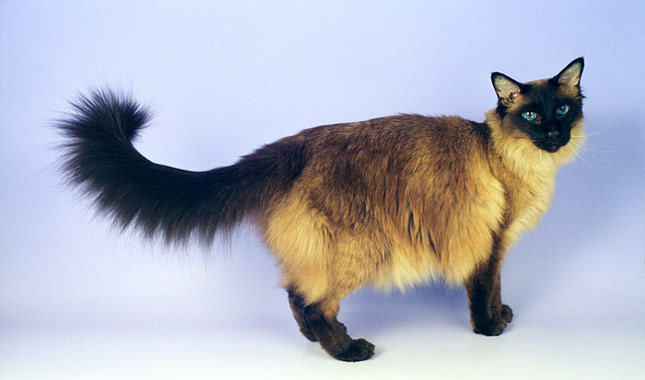Balinese
Published on July 12, 2011
Breed Characteristics
Adaptability
Energy Level
Child Friendly
Social Needs
Shedding Level
Grooming
Health Issues
Stranger Friendly
Affectionate
Dog Friendly
Intelligence
The primary difference between the Balinese and the Siamese is coat length, with the Balinese having long, silky hair and a plumed tail. The Balinese shares the svelte but muscular body of the Siamese, as well as his wedge-shaped head, blue eyes, large triangular ears and striking color points.
Lots of adjectives apply to the Balinese: busy, outgoing, inquisitive, affectionate, demanding, loyal and intelligent. He’s the Siamese dressed up to the nines, sporting a long, silky coat with the same sophisticated color points that distinguish the Siamese.
Is the Balinese a Siamese in drag or is he a manmade creation? No one is really sure. A number of cat breeds have been created by crossing the Siamese with something else, but the Balinese is not thought to be one of them, although there are theories that he might have been the result of crosses between Siamese and Angora or Persian cats in the 1920s. He is generally considered a natural breed, the result of a spontaneous genetic mutation for a longhaired coat within the Siamese breed.
The primary difference between the Balinese and the Siamese is coat length. The five to nine pound Balinese shares the svelte but muscular body of the Siamese, as well as his wedge-shaped head, blue eyes, large triangular ears and striking color points.
Other Quick Facts
- The Balinese looks like a longhaired Siamese and comes in the same Siamese point colors: seal, chocolate, blue and lilac.
- The Balinese is highly active and vocal. He wants to be involved in everything that’s going on in the home.
- Keep a Balinese indoors to protect him from cars, diseases spread by other cats and attacks from other animals.
- The Balinese is a chatty cat; he will talk your ear off if you let him.
The History of the Balinese
The Balinese is a magical cat. How else to explain his lack of history, his sudden appearance on the world cat stage? Oh, there are references here and there to a longhaired Siamese on a Chinese tapestry, a mention of one in an 1871 issue of Penny Illustrated magazine, and a Cat Fanciers Federation registration record for one in 1928, but very little is known of how he came to be.
If the magical explanation doesn’t work for you, the more pragmatic one is that he is the result of a natural mutation for long hair in the Siamese. Longhaired kittens showed up occasionally in Siamese litters, but the first breeding program for them didn’t begin until the 1950s. Siamese breeders Marion Dorsey in California and Helen Smith in New York each had longhaired kittens born in Siamese litters and fell in love with them. In a romantic gesture, Smith called them Balinese because their grace and elegance reminded her of the dancers for which the island of Bali is famous.
The International Cat Association recognized the Balinese in 1979. The cats are also recognized by the Cat Fanciers Association and other cat registries.
Balinese Personality and Temperament
Balinese may look beautiful and sophisticated, but they are clowns at heart. Demanding clowns. They love you and they want to help you with whatever you’re doing, all the time. This makes them easy to train, or is it that the Balinese has trained you? He can walk you on a leash and teach you to watch him do tricks. There’s little he can’t do as long as it doesn’t require opposable thumbs, and sometimes even that lack isn’t an obstacle for him. Living with such a smart cat can be tiring unless you have an excellent sense of humor, so be sure you are willing to make the effort.
Like the Siamese, the Balinese likes to talk. He has a somewhat softer voice than the Siamese, but his conversation is just as scintillating.
This is an extroverted cat who gets along well with kids, dogs and other cats.
What You Need to Know About Balinese Health
All cats have the potential to develop genetic health problems, just as all people have the potential to inherit diseases. Any breeder who claims that her breed has no health or genetic problems is either lying or is not knowledgeable about the breed. Run, don’t walk, from any breeder who does not offer a health guarantee on kittens, who tells you that the breed is 100 percent healthy and has no known problems, or who tells you that her kittens are isolated from the main part of the household for health reasons.
Balinese are generally healthy. Health issues that may affect the Balinese include lysosomal storage disease, a condition that can result neurological signs, and feline acromelanism, a condition that can causes changes in coat color with variations in temperature. Never buy a kitten from a breeder who does not provide a health guarantee. A guarantee does not mean that your kitten will not ever get any of these conditions, but it indicates a breeder who is willing to stand behind what she produces.
Remember that after you’ve taken a new kitten into your home, you have the power to protect him from one of the most common health problems: obesity. Keeping a Balinese at an appropriate weight is one of the easiest ways to protect his overall health. Make the most of your preventive abilities to help ensure a healthier cat for life.
The Basics of Balinese Grooming
The silky coat of the Balinese does not shed much and is easy to groom with weekly brushing. The only other care he requires is weekly nail trimming and occasional ear cleaning. He can develop periodontal disease, so it’s important to brush his teeth at home with a vet-approved pet toothpaste and schedule veterinary cleanings as needed.
Choosing a Balinese Breeder
You want your Balinese to be happy and healthy so you can enjoy your time with him, so do your homework before you bring him home. For more information on the history, personality and looks of the Balinese, or to find breeders, visit the websites of the Cat Fanciers Association, Cats Center Stage, the Fanciers Breeder Referral List, and The International Cat Association.
A reputable breeder will abide by a code of ethics that prohibits sales to pet stores and wholesalers and outlines the breeder’s responsibilities to their cats and to buyers. Choose a breeder who has performed the health certifications necessary to screen out genetic health problems to the extent that is possible, as well as one who raises kittens in the home. Kittens who are isolated can become fearful and skittish and may be difficult to socialize later in life.
Lots of reputable breeders have websites, so how can you tell who’s good and who’s not? Red flags include kittens always being available, multiple litters on the premises, having your choice of any kitten, and the ability to pay online with a credit card. Those things are convenient, but they are almost never associated with reputable breeders.
Whether you’re planning to get your feline friend from a breeder, a pet store, or another source, don’t forget that old adage “let the buyer beware”. Disreputable breeders and unhealthy catteries can be hard to distinguish from reliable operations. There’s no 100% guaranteed way to make sure you’ll never purchase a sick kitten, but researching the breed (so you know what to expect), checking out the facility (to identify unhealthy conditions or sick animals), and asking the right questions can reduce the chances of heading into a disastrous situation. And don’t forget to ask your veterinarian, who can often refer you to a reputable breeder, breed rescue organization, or other reliable source for healthy kittens.
Put at least as much effort into researching your kitten as you would into choosing a new car or expensive appliance. It will save you money in the long run.
Be patient. Depending on what you are looking for, you may have to wait six months or more for the right kitten to be available. Many breeders won’t release kittens to new homes until they are between 12 and 16 weeks of age.
Before you buy a kitten, consider whether an adult Balinese might be a better choice for your lifestyle. Kittens are loads of fun, but they’re also a lot of work and can be destructive until they reach a somewhat more sedate adulthood. With an adult, you know more about what you’re getting in terms of personality and health. If you are interested in acquiring an adult cat instead of a kitten, ask breeders about purchasing a retired show or breeding cat or if they know of an adult cat who needs a new home.
Adopting a Cat from Balinese Rescue or a Shelter
The Balinese is an unusual and uncommon breed. It is unlikely that you will find one in a shelter or through a rescue group, but it doesn’t hurt to look. Sometimes pedigreed cats end up at the shelter after losing their home to an owner’s death, divorce or change in economic situation. Check the listings on Petfinder,Adopt-a-Pet.com or the Fanciers Breeder Referral List, and ask breeders if they know of a Balinese who is in need of a new home.
Wherever you acquire your Balinese, make sure you have a good contract with the seller, shelter or rescue group that spells out responsibilities on both sides. In states with “pet lemon laws,” be sure you and the person you get the cat from both understand your rights and recourses.
Kitten or adult, take your Balinese to your veterinarian soon after adoption. Your veterinarian will be able to spot problems, and will work with you to set up a preventive regimen that will help you avoid many health issues.










